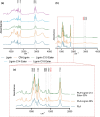Novel Softwood Lignin Esters as Advanced Filler to PLA for 3D Printing
- PMID: 39524619
- PMCID: PMC11541478
- DOI: 10.1021/acsomega.4c06680
Novel Softwood Lignin Esters as Advanced Filler to PLA for 3D Printing
Abstract
In this study, we explored the selectivity of softwood lignin toward esterification through chloromethylation. Organosolv pine lignin chloromethylated by a novel greener protocol was subjected to esterification with decanoic acid (C10), tetradecanoic acid (C14), and stearic acid (C18). The success of lignin esterification was confirmed by using FTIR and NMR spectroscopy. For composite preparation, modified lignin was incorporated with PLA in varying proportions (10%, 20%, 30%, and 40%) using the solvent casting technique. The thermal and mechanical properties of the solvent-cast films were analyzed. Notably, lignin esters increased the glass transition temperature (T g) of PLA by a few degrees: tetradecanoic acid (C14) at 30% loading exhibited increases T g from approximately 68 to 72 °C. Mechanical testing showed that blending PLA with lignin and its ester derivatives improves its properties. Pure PLA has moderated ductility and stress but lowered stress levels compared to PLA-lignin ester blends. Adding 30% lignin reduced strength and strain, making the material more brittle. In contrast, the PLA + lignin C14 ester (30%) blend achieved the highest stress and strain, enhancing toughness and strength. This makes lignin C14 ester a promising additive for improving the mechanical properties of PLA in applications requiring greater strength and toughness. The composition with optimum properties was selected for production of the 3D-printing filament. Three extrusion temperatures were evaluated, and the advanced mechanical properties of 3D-printed filament along with surface morphology were analyzed.
© 2024 The Authors. Published by American Chemical Society.
Conflict of interest statement
The authors declare no competing financial interest.
Figures










References
-
- Rahim M.; Douzane O.; Tran Le A. D.; Promis G.; Laidoudi B.; Crigny A.; Dupre B.; Langlet T. Characterization of Flax Lime and Hemp Lime Concretes: Hygric Properties and Moisture Buffer Capacity. Energy Build 2015, 88, 91–99. 10.1016/j.enbuild.2014.11.043. - DOI
-
- Zhang Y.; Yan D.; Hu S.; Guo S. Modelling of Energy Consumption and Carbon Emission from the Building Construction Sector in China, a Process-Based LCA Approach. Energy Policy 2019, 134, 110949.10.1016/j.enpol.2019.110949. - DOI
-
- Global Plastics Outlook: Economic drivers, environmental impacts and policy options. OECD. 21 June 2022.
-
- Chalmin P. The History of Plastics: From the Capitol to the Tarpeian Rock. Field Actions Sci. Rep 2019, (Special issue 19), 6–11.
-
- Weiss M.; Haufe J.; Carus M.; Brandão M.; Bringezu S.; Hermann B.; Patel M. K. A Review of the Environmental Impacts of Biobased Materials. J. Ind. Ecol 2012, 16 (s1), S169.10.1111/j.1530-9290.2012.00468.x. - DOI
LinkOut - more resources
Full Text Sources
Miscellaneous
